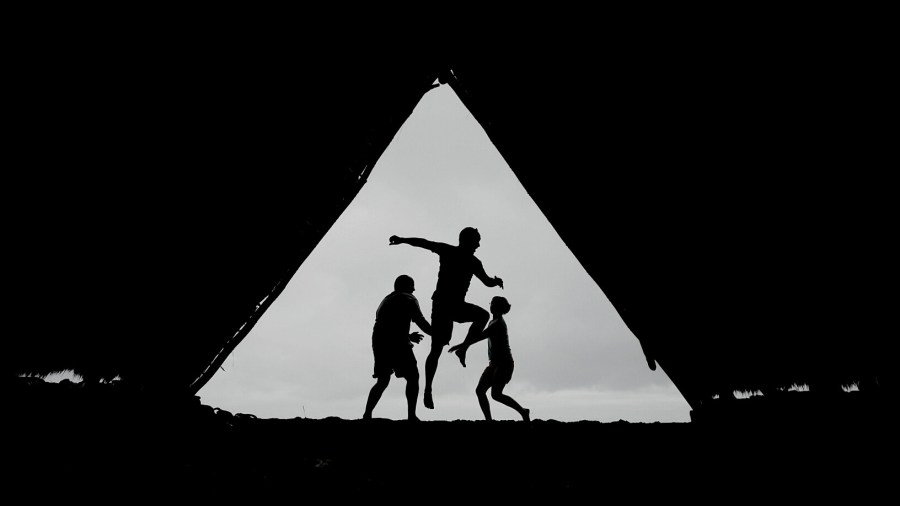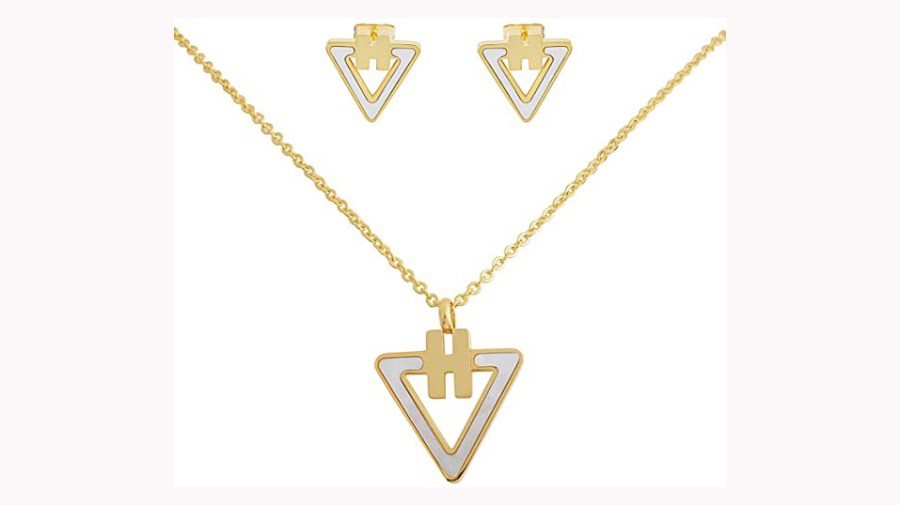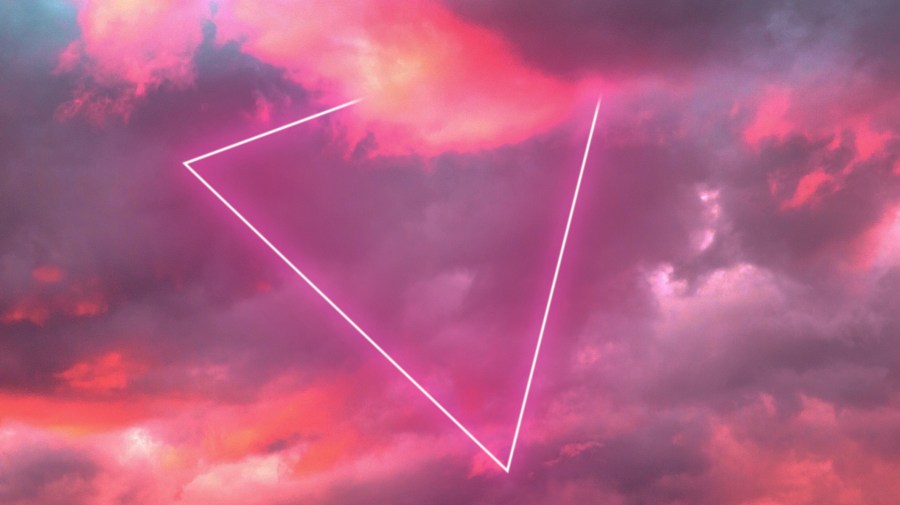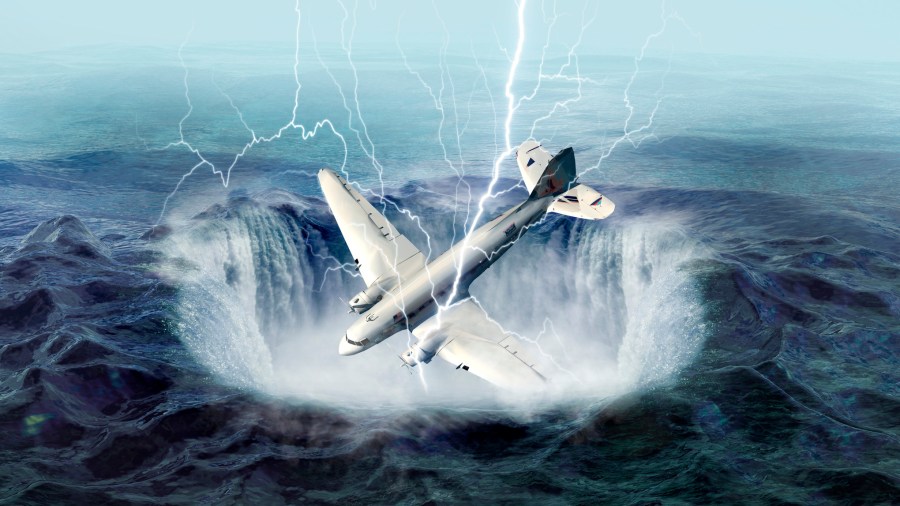What Does an Upside-Down Triangle Mean?

When an upside-down triangle appeared in a recent ad for President Trump’s election campaign, it fanned the flames of controversy that frequently surround the polarizing President. The symbol’s long-ago link to Nazi concentration camps outraged President Trump’s critics and prompted Facebook to remove the ads for “violating its policy against organized hate.” On the other side of the aisle, the President’s campaign leaders and supporters argued the symbol was merely an emoji-like representation of antifa, the focus of the ad.
As the debate rages on, it has many people in America wondering about the symbolism of the triangle and what it really means. The answer isn’t as simple as you might have imagined. The simple triangle has popped up continuously throughout history as a symbol used to represent many very different things, with the earliest appearances dating back to ancient civilizations. Let’s take a look at the complicated history of the extremely symbolic triangle.
Power of Three
Just as simple gestures sometimes mean the most, simple shapes sometimes send the most profound message. The simple — yet, oh, so symbolic — triangle is the perfect example. A basic triangle has been used throughout history to convey an astonishing number of meanings. As a three-sided figure, the triangle has an eternal connection to the number three that is often illustrated in its different symbolic meanings. Mystical teachings, for example, often rely on the power of three to accomplish their goals.

In numerology, the number three has a lot of significance, including the ability to bring good luck. The belief that three is a lucky number is the source behind the “third time’s a charm” saying, and that connection to luck translates to the three-sided triangle. The number three also represents optimism, creativity, inspiration and expression and has a spiritual meaning that revolves around magic and intuition.
The symbolic idea behind most triads is that two of the sides represent two aspects that combine to create the third aspect. This is at the heart of the triangle’s relationship with creation and creativity. In fact, the number is often linked to creativity, rewards and successful undertakings.
Gender Influences
A geometric triangle may not seem like it has anything to do with the battle of the sexes, but that wasn’t always true, historically speaking. In ancient times, a triangle sitting upright — point at the top — represented the “blade,” a symbol for men. In the patriarchal civilizations of the past, the blade was a symbol of male force, fire, dominance, aspiration and principles. The symbol itself also has phallic connotations, as represented by the upright point that is intended to illustrate the dominance of males.

The triangular blade is also implied in the male gender symbol, which features the arrow that resembles the point of a triangle. This symbol comes from the Roman god Mars, who was renowned for his masculine strength and skills. From a modern perspective, the United States Army today still uses rank insignias that resemble a triangle. A sergeant has more stripes (triangles) than a private, a colonel has more stripes than a sergeant, etc. Greater power and authority are recognized by the awarding of more triangular stripes.
On the other hand, an upside-down triangle — point at the bottom — looks a bit like a stemless wine glass and is actually known as the “chalice.” While the blade was supposed to bring phallic imagery to mind in the past, the chalice was more open in appearance and was supposed to represent the womb. Additionally, water is the element most often used to represent women and femininity, which could also connect to the idea of a feminine chalice.
Ancient civilizations associated women with Venus, the Roman goddess of love. Consequently, females were expected to look visually appealing and be soft, hospitable and caring. The connection to the gender symbol for females is a bit less obvious, but the female symbol does include what vaguely resembles four small chalices created by the cross at the bottom.
Religious Influences
Geometric shapes — triangles among them — are common figures in historical religions. Many triangle-centric symbols existed long before ancient civilizations like the Egyptians and Greeks put them to scientific use in various construction projects. Greek philosopher and mathematician Pythagoras — yes, the one behind the famous theorem — believed that geometry played a much larger role in the universe than its use in simple mathematical applications. He assigned much deeper meanings to different shapes, and his interpretations heavily influenced the beliefs that developed in western philosophies. Over time, the most significant and lasting meanings that developed generally related to religious or magical uses.

Many ancient civilizations used triangles to represent specific elements of their religion. Perhaps the most recognized usage is in the Christian religion, which uses the triangle to represent the Holy Trinity made up of the Father, Son and Holy Spirit. Greek and Roman mythology also had triangular trinities consisting of Zeus, Poseidon and Hades (Greek) and Jupiter, Neptune and Pluto (Roman). In Egyptian mythology, Osiris, Isis and Horus made up another important religious trinity.
Overlapping an upright triangle and an upside-down triangle forms the iconic Star of David, the most widely recognized symbol of the Jewish religion. Separately, the two triangles represent a balance of two opposite forces. If you refer back to the idea of the blade and the chalice, men with their power and dominance and women with their softness and submissiveness represent these opposing forces. Unite the two triangles to form the star, and it symbolizes a balance between the two forces. While this symbol is an important Jewish symbol, it can also be found in Hinduism and Buddhism, also representing balance in those religions.
Spiritual Influences
The triangle has also been used throughout history to represent different types of spiritual and metaphysical trinities, such as mind, body and spirit; past, present and future; life, death and rebirth; waxing, waning and full (moon); love, truth and wisdom; and maiden, mother and crone. Mahayana Buddhism focuses on three distinguishing bodies: Dharmakaya or “body of essence,” which is the unmanifested mode (supreme state of absolute knowledge); Sambhogakaya or “body of enjoyment,” which is the heavenly mode; and Nirmanakaya or “body of transformation,” which is the earthly mode (Buddha on Earth).

On the darker side of religion, those who studied the occult and practiced occult rituals sometimes used triangles as summoning symbols. While the practitioner generally relied on performing rituals from inside the safety of a circle, he or she expected the summoned entity to appear within a triangle drawn on the floor.
Mystical Influences
After all those years of math classes, many people learned to think of a triangle purely in mathematical terms. The shape certainly plays a key role in science, particularly in the engineering field. Historically, triangles were also frequently used to represent mystical and magical characteristics that go far beyond the realm of empirical science. They are common shapes in historical texts and art related to mysticism.

Strength is one key triangle meaning that actually has roots in physical science. Triangles are literally the strongest geometric shape. Weight placed on a triangle naturally distributes evenly to all three sides, making it much less likely to collapse. Mystically speaking, the triangle often depicts emotional strength and character, although it could also represent physical strength.
The versatility of the triangle exhibits themes of magic, wonder and creativity, depending on the way it’s used. None of the other shapes accomplish this feat. A square means the same thing, no matter which way you turn it, and a circle offers no variation at all for creating a different meaning. The triangle, however, means something entirely different when it’s turned upside-down.
Elemental Influences
Aristotle and the ancient Greeks identified four physical elements — fire, air, water and earth — and one non-physical element — spirit or aether. Alchemists assigned these elements symbols that were all variations of the triangle. Fire is represented by an upright triangle, while its elemental opposite, water, is an upside-down triangle. Air is represented by an upright triangle with a horizontal line crossing through the triangle near the top point. Earth flips that triangle upside-down so the horizontal line crosses through the triangle near the point at the bottom. The non-physical spirit element is represented by the opposing, overlapping triangles of the Star of David.

In many cases, the orientation of a triangle affects the meaning. Upright triangles with the point at the top sit on a strong base. Because strength usually represents male energy, it’s associated with fire and air elements and can be seen in those symbols created by alchemists. In contrast, an upside-down triangle represents female energy and is used in the symbols for water and earth, the two feminine elements. When the two triangles overlap in opposing positions, they form the hexagram better known as the Star of David. The combination represents both unity and harmony as well as diversity.
Triangles were often used in rituals, and the triangle element symbols often appeared in written magic and spells. Astrologers also use the elements to characterize different signs in the zodiac based on specific elemental characteristics. Those with fire element signs are expected to be courageous, strong and passionate, while those with water element signs are believed to have healing powers and pure, peaceful demeanors. Air zodiac signs are believed to be great communicators who have an abundance of both intelligence and imagination. Signs with the earth element are said to represent grounded stability as well as fertility.
Cultural Influences
Many of civilizations’ most significant cultures incorporated triangles as symbolic shapes characterized by deeper meanings. Notable examples include the Celtic civilization with its intricate knots, the Egyptian civilization with its pyramids and the Freemasons with their Eye of Providence, also known as the all-seeing eye, encased in a triangle.

The Celtic culture, in particular, features numerous references to the number three. It’s apparent in the triskelion, which resembles three connecting spirals, the triquetra, which resembles a knot of rounded triangles, and various other Celtic knot motifs. The frequent references to three in Celtic life also include the culture’s classification of worlds: other world, mortal world and celestial world.
Pyramids
Pyramids are essentially three-dimensional versions of triangles that usually consist of a four-sided base and four triangular sides, although the number of sides may vary, depending on the shape of the base. The Egyptian pyramids illustrate the most famous use of triangles historically, but pyramids have also been core elements in magic and meditation throughout history. The shape pops up in many historical records, particularly those related to using crystals for everything from attracting mates to healing.

Archaeologists don’t have a definite answer for why the ancient Egyptians chose the pyramid shape for their tombs, but many believe the choice had to do with the Egyptian sun god Ra. The god supposedly sat on a pyramid-shaped mound of dirt that rose from the primordial sea. Also tying in to this theory, the shape resembles the dispersal pattern of the sun’s rays.
Viking Valknut
Popular in tattoos, a valknut symbol features three interlocked triangles. The name comes from Old Norse and means “knot of those fallen in battle.” The actual meaning of the symbol is the subject of unresolved debate. Archaeologists aren’t certain why ancient Germanic tribes etched the symbol into artifacts, but they believe it relates to mythology and the Norse god Odin. The valknut symbol has been found on prominent artifacts throughout history, including a golden ring that dates back to the late eighth or early ninth century and a Viking ship found in Norway that dates back to the year 800. The famous image stones Stora Hammars I and Tangelgarda in Sweden also contain valknut symbols.

The modern use of the symbol usually relates to paganism and heathenry, although those aren’t the only meanings. The connection to Odin and the symbol’s presence on various artifacts that relate to memorials or burials point to a likely connection to death in ancient cultures. In terms of more controversial usage, some white nationalist groups have used the valknut as representative symbols for their organizations.
Sri Yantra
The Sri Yantra is a sacred geometrical symbol in Hinduism. It consists of nine interlocking triangles that spread out from a central point, ultimately creating a total of 43 smaller triangles with a center that represents the point between the physical world and the spiritual world. The nine main triangles point both upward and downward, symbolizing the union of the masculine and the feminine. As a result, many people wear the symbol as a talisman for strong relationships.

Modern Triforce
Modern gamers and fans of the iconic The Legend of Zelda video games recognize the Triforce symbol as a source of “ultimate power,” which aligns with many of the cultural triangle interpretations throughout history. In the game’s ancient literature, it relates to the Golden Goddesses: Din, Goddess of Power; Nayru, Goddess of Wisdom; and Farore, Goddess of Courage.

Three triangles combine to create the Triforce, each with its own meaning. The Triforce of Wisdom sits on the left with its right base point touching the left base point of the Triforce of Courage on the right. The Triforce of Power sits above the two and balances on their top points. Together, the three triangles form one larger triangle with a void in the middle in the shape of an upside-down triangle. In the game, the royal family’s crest features the Triforce symbol, and acquiring all three Triforces creates perfect balance and providence.
Darker Modern Usage
In the past, triangles often represented strength and power in a positive light, but modern triangles sometimes have darker connotations. For example, ancient upside-down triangles were often tied to softer feminine characteristics, but that wasn’t the case in Nazi Germany. The Nazis used upside-down triangles on clothing to designate different types of prisoners. For example, red upside-down triangles meant they were political prisoners, while pink upside-down triangles identified men who were gay. It’s important to note the LGBTQ community has revamped the pink triangle in recent years and uses it as a tribute to the atrocities they have survived. The double yellow triangles arranged to form the Star of David classified prisoners as Jews.

In everyday life, triangles on roadways send an ominous message warning of approaching danger or reasons to be cautious. In the U.S., the most prominent triangular sign is the Yield sign, which cautions drivers to yield the right of way to vehicles coming from other directions. If drivers ignore the warning, the consequences could be catastrophic. Various other warnings appear on triangular signs in other countries and sometimes in the U.S., including the critical biohazard warning. Additionally, the safety reflectors in emergency kits in vehicles are often triangles.
Dangerous Triangles?
Beyond the scope of symbolism, a couple of geographical triangles send shivers down some spines on completely opposite sides of the world — at least among those who are superstitious. The infamous Bermuda Triangle encompasses the triangular stretch of ocean between Miami, Bermuda and Puerto Rico. Over the course of decades, many ships and planes have mysteriously disappeared from the zone also known as the Devil’s Triangle. To this day, their disappearances have never been explained.

On the other side of the world, the equally infamous Dragon’s Triangle encompasses the span of ocean between the Philippines, Guam and Miyake, Japan, and has a spooky history of its own. Fables written about the area, also called the Devil’s Sea, tell of a mythical dragon that drags ships and sailors down into the murky depths. The stories themselves may be straight out of a fantasy novel, but the unexplained disappearances are cold, hard fact.





